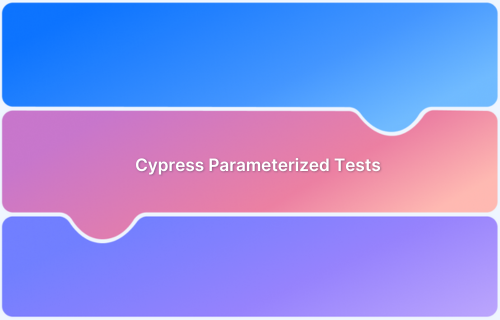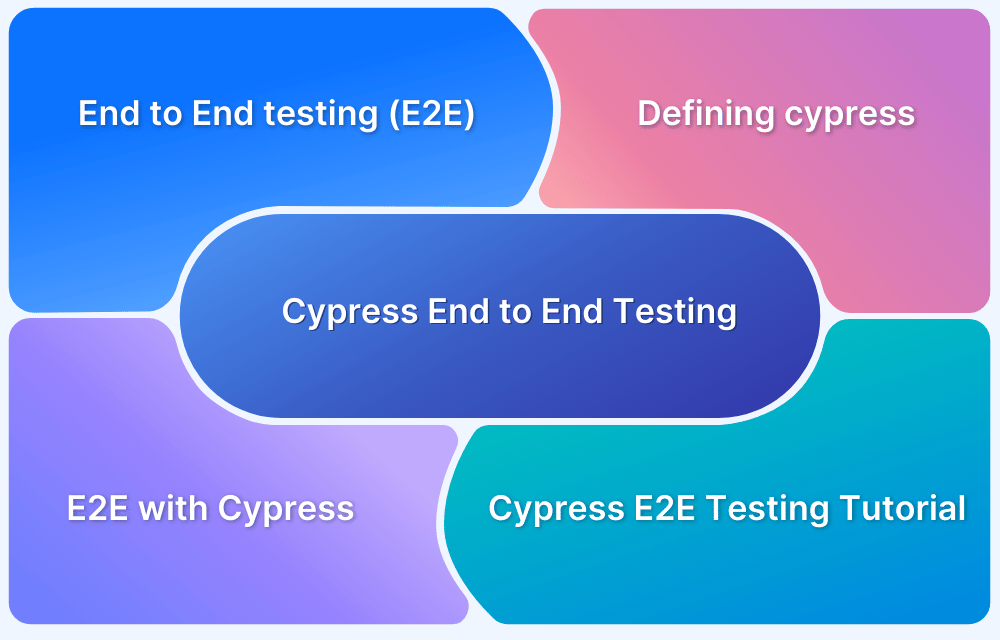Parameterization is a technique used in testing to systematically vary the input values of a test case without duplicating the test itself. It allows testers to execute a single test case multiple times with different sets of data, thereby increasing the coverage and effectiveness of the testing process.
By parameterizing the test data, testers can explore various scenarios and edge cases, ensuring the software behaves correctly across various inputs.
What is Cypress Parameterized Testing?
Cypress parameterized testing allows running the same test with different input values. By passing multiple data sets, it helps validate various scenarios efficiently, ensuring robust coverage and minimizing repetitive test code.
In Cypress testing, the parameterization can feed test data to a recurring test flow. This can be achieved through a few methods. To initiate parameterized testing in Cypress, fixtures can be used.
Cypress Fixtures for Parameterized Testing in Cypress
Cypress fixtures are static files (typically JSON or CSV) containing test data used in your tests. They help store and load data like user details or product info, enabling parameterized tests and ensuring consistent, reusable input for automated testing.
Fixtures are the most common and the best method for Cypress testing with parameterization. In fixtures, a data set with “key/value” pairs is maintained.
This JSON is the most used and recommended form, as the Cypress spec file is written in Javascript. Otherwise, any key/value pair storing data structure can be used according to the tech stack and the data usage purposes.
These data files are stored under the fixtures folder, and when the spec files are scripted in the before() section, the fixtures need to be loaded and declared.
The parameterized testing is also done with plugins and environment variables in some languages and frameworks. Still, since employing fixtures is one of Cypress’s best practices, users are not recommended to use the other means.
Benefits of Parameterization in Testing
To achieve steady and uninterrupted test flows with error-free codes, parameterization is used. The parameterization of the tests uses a set of parameters fed to a common test flow which alters the input states and will have differentiated outputs for each.
Here are a few benefits of Cypress parameterization will bring to the test suite
- High efficiency: The tests will be written and executed efficiently as the reusability of the code base is practiced.
- Easy to troubleshoot: Troubleshooting the test cases is easy as the test flow for many test cases will be the same. If the results are still faulty or buggy, they can be troubleshot by recleaning the parameterized test dataset.
- Flexibility and scalability: Adapting the Cypress test suite to changing requirements or variations in the system under test becomes more manageable with parameterization.
- Customization and personalization: Test parameterization allows for the customization and personalization of tests based on specific conditions or user preferences.
- Improved defect detection: By exploring a more comprehensive range of test scenarios through parameterization, you increase the likelihood of uncovering defects or issues that may be missed in a narrower set of tests.
- Documentation and reporting: By including the parameter values in test reports or logs, you can provide detailed information about the test coverage, configurations, and data used during testing. This facilitates traceability and aids in identifying specific test scenarios that led to issues or failures.
Also Read: Handling Test Failures in Cypress
Example of Writing a Parameterized Test with Cypress Fixtures
For this particular example, a Google form is used.
In this scenario, the name variables for the Google form are coded in JSON format inside a separate file named “names.json” inside the fixtures directory. Inside this JSON file, multiple values can be added. Then inside the test class, the “names” fixture class is called, and the values will be obtained using for each loop, which then is fed to the input field of the Google form.
describe('Parameterized tests with Cypress', ()=> {
beforeEach(function(){
cy.fixture('names').then((names) =>{
this.names = names
})
})
it('Check for Dynamic click', function() {
cy.visit('enter form link')
cy.wait(4000)
cy.xpath('//*[@id="mG61Hd"]/div[2]/div/div[2]/div[1]/div/div/div[2]/div/div[1]/div/div[1]/input').should('be.visible').type(this.names.fname)
cy.xpath('//*[@id="mG61Hd"]/div[2]/div/div[2]/div[2]/div/div/div[2]/div/div[1]/div/div[1]/input').should('be.visible').type(this.names.lname)
})
})The Parameterized Test
{
"fname": "Gaveen",
"lname": "Nayanajith"
}The Fixture file for the name parameters
Best Practices for Parameterization in Cypress Testing
Here are the key best practices for Parameterization in Cypress Testing:
Parameterization can significantly enhance the effectiveness and maintainability of Cypress tests. By leveraging parameterization, you can write more reusable and scalable tests. The best practices that should be used in a parameterized test are the same as those used in the normal Cypress test.
Some of the crucial ones can be listed as follows:
- Identify Test Scenarios: Identify different test scenarios or variations you want to parameterize. These scenarios typically involve other inputs or conditions that need to be tested.
- Create Test Data: Prepare the test data that will be used for parameterization. This can include various sets of input values, configuration options, or test fixtures.
- Script Readable Test Cases: The test cases should be readable using comments. Since several Quality engineers use a codebase, the tests should be readable as they can be subjected to changes and altercations.
- Avoid Hard Coding: As we use strict directory policies along with the fixtures, hard coding should be avoided as it can be the main reason for the imbalance of our architecture.
- Use Descriptive Names: This is the most important practice that needs to be enforced when parameterization is done. Because the descriptive test will be the key to finding the test flow as most of them will have the same skeleton while the test will only be changed. So to identify the changed test flows, we must have descriptive test names.
- Log and Report: Enhance your test reporting by logging the parameter values for each test iteration. This will help you identify the data that led to test failures or issues.
Why use BrowserStack Automate to run Cypress Parameterized Tests?
You should run Cypress Parameterized Tests on a real device cloud like BrowserStack Automate for below reasons:
- Cypress does not allow running parallel tests on local: You would need to set up an external infra like BrowserStack automate and integrate with Cypress to run parallel tests seamlessly.
- Realistic Testing Conditions: Real device clouds provide access to a broad spectrum of devices and environments, ensuring tests reflect actual user conditions accurately.
- Enhanced Security: Maintained with high security standards, real device clouds offer secure, isolated testing environments, minimizing data breach risks.
- Broad Browser and OS Coverage: Helps identify compatibility issues across various browsers and operating systems, enhancing user experience.
- Performance Insights: Real devices yield authentic performance data essential for optimizing application responsiveness.
- Scalability and Accessibility: Facilitates scalable and accessible testing, suitable for distributed teams.
- CI/CD Integration: Integrates smoothly with CI/CD pipelines for continuous testing and early issue detection.
- Cost-Effectiveness: Although initially more costly, it saves on long-term expenses related to fixes and support.







